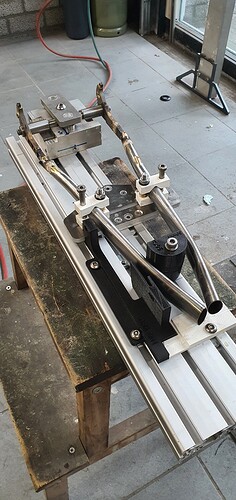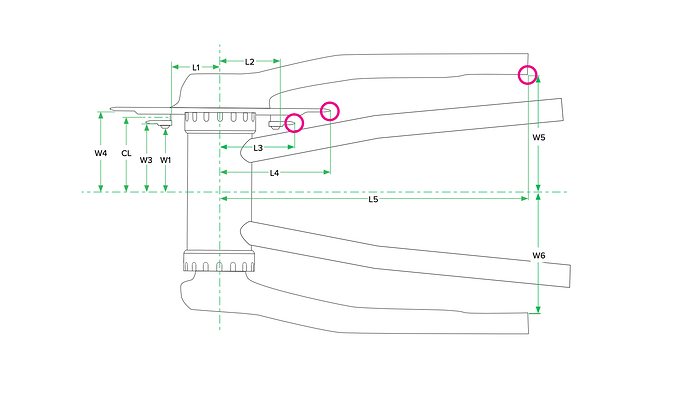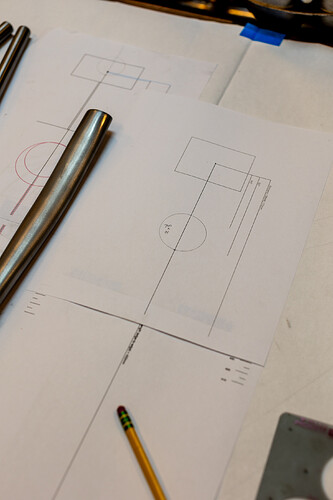Hey Joe -
I’ll add a sympathetic “good luck”. I compiled this data for all the major cranks a couple of years ago. I would share the spreadsheet, but it’s in serious disrepair at this point. Here were my conclusions…
- You only truly need to know two/three/four (1x/double/triple) X/Y coordinates for any given crank. The different manufacturer’s provide a bunch of different dimensions, most of which are just clutter. The important ones are circled below in pink. (L3/W3; L4/W4; L5/W5). This is a page from a SRAM tech manual, but all the drawings include these points. (Sure, you may occasionally run into a situation where a chainring bolt or the middle of the crank arm affects clearance, but if you’re building to that tight a clearance you probably already have–or should have–the crankset on-hand.)
-
Yes–as you mention–chainring diameter is linear and consistent. This shouldn’t be surprising… There are several “chainring diameter calculators” and charts out there.
-
Similarly, crank arm length is pretty consistent. Take the arm length and add 15mm and you’ll get very close to that L5 dimension for most cranks.
-
Published “Chainline” isn’t a very helpful dimension, for a bunch of reasons. You really do need the technical drawings from the manufacturers’ frame fit specs.
-
There’s a lot of overlap between manufacturers’ similar cranks, and then are some frustrating outliers. I’m sure Campy EKAR has bitten a lot of builders… Take a look at the drawings and you’ll immediately see why.
-
Don’t even try to account for power meters, crank boots, etc. Again, if someone is dealing with those items and pushing clearances, they should have them on-hand.
Here are most of the drawings, if anyone is having trouble finding them:
SRAM Road/Gravel:
https://www.sram.com/globalassets/document-hierarchy/frame-fit-specifications/road/2023-road-frame-fit-specifications.pdf. Cranks starts on Page 34
SRAM Mountain:
https://www.sram.com/globalassets/document-hierarchy/frame-fit-specifications/mtb/2023-mtb-frame-fit-specifications.pdf. Cranks start on Page 16
White Industries Square Taper:
https://www.whiteind.com/support/technical-documents/crank-drawings/
White Industries M/G/R30:
https://www.whiteind.com/support/technical-documents/mr30-crank-and-chainring-dimensional-drawings/
Shimano:
Shimano-Cranks2020.pdf (550.0 KB)
Campagnolo:
Campy_CX.pdf (2.6 MB)
Campy_Record.pdf (2.9 MB)
Campy_EKAR.pdf (3.0 MB)
Campy_Potenza.pdf (3.0 MB)
Most of the others… RaceFace/Ingrid/Etc… all have drawings available too. They’re usually in the “Support” section of each individual crankset’s product page. Yes, even most of the manufacturers can’t seem to put all of their specs in one spot! (Thank you, thank you White Industries… You might be the only one.)
In the end, I ditched this effort… Instead I determined the narrowest clearance and longest crank arm dimension for each “type” of crank (Road Double, Gravel 1x, etc.) regardless of brand, and we just built our frames to those specs. And if someone specified “Sram/Shimano Gravel 1x” to us and then they slapped a EKAR crank on the frame and wondered why things didn’t clear, well…
Sincerely, good luck! I’ve been hoping someone smarter like you would do this at some point and keep it all neatly organized. If you can do it in a universally discernible way and keep it up to date, you’ll deserve a huge thanks.
PS. If anyone out there uses Adobe InDesign, I made a tool to easily produce 2D chainstay overview drawings. It includes the major cranks on different layers. You can hide/show the cranks and rear hub spec, and print out a full-scale drawing to use during a build. Chainstay length is accounted for by taping the two sheets of paper together using the scale. It’s hokey, but it works great. Then you just draw the tire in by hand and you’re good to go. Here’s a sample. I can’t seem to attach an InDesign file here, but if you’d like a copy shoot me an email.
ChainstayWorksheet-Sample.pdf (34.1 KB)
-Chris


